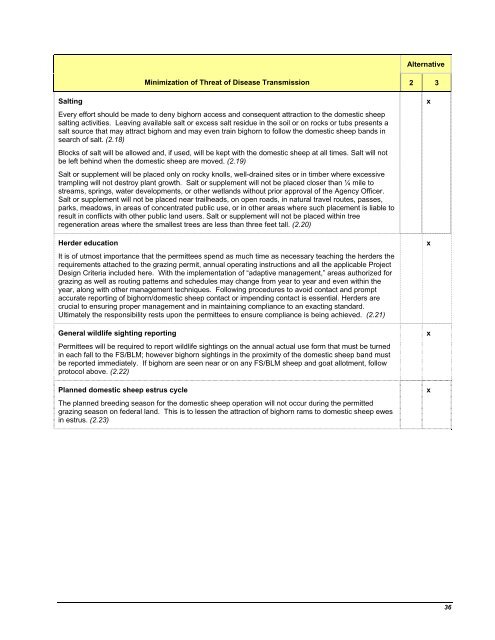NEPA--Environmental Assessment
NEPA--Environmental Assessment
NEPA--Environmental Assessment
Create successful ePaper yourself
Turn your PDF publications into a flip-book with our unique Google optimized e-Paper software.
Alternative<br />
Minimization of Threat of Disease Transmission 2 3<br />
Salting<br />
Every effort should be made to deny bighorn access and consequent attraction to the domestic sheep<br />
salting activities. Leaving available salt or excess salt residue in the soil or on rocks or tubs presents a<br />
salt source that may attract bighorn and may even train bighorn to follow the domestic sheep bands in<br />
search of salt. (2.18)<br />
Blocks of salt will be allowed and, if used, will be kept with the domestic sheep at all times. Salt will not<br />
be left behind when the domestic sheep are moved. (2.19)<br />
Salt or supplement will be placed only on rocky knolls, well-drained sites or in timber where excessive<br />
trampling will not destroy plant growth. Salt or supplement will not be placed closer than ¼ mile to<br />
streams, springs, water developments, or other wetlands without prior approval of the Agency Officer.<br />
Salt or supplement will not be placed near trailheads, on open roads, in natural travel routes, passes,<br />
parks, meadows, in areas of concentrated public use, or in other areas where such placement is liable to<br />
result in conflicts with other public land users. Salt or supplement will not be placed within tree<br />
regeneration areas where the smallest trees are less than three feet tall. (2.20)<br />
Herder education<br />
It is of utmost importance that the permittees spend as much time as necessary teaching the herders the<br />
requirements attached to the grazing permit, annual operating instructions and all the applicable Project<br />
Design Criteria included here. With the implementation of “adaptive management,” areas authorized for<br />
grazing as well as routing patterns and schedules may change from year to year and even within the<br />
year, along with other management techniques. Following procedures to avoid contact and prompt<br />
accurate reporting of bighorn/domestic sheep contact or impending contact is essential. Herders are<br />
crucial to ensuring proper management and in maintaining compliance to an exacting standard.<br />
Ultimately the responsibility rests upon the permittees to ensure compliance is being achieved. (2.21)<br />
General wildlife sighting reporting<br />
Permittees will be required to report wildlife sightings on the annual actual use form that must be turned<br />
in each fall to the FS/BLM; however bighorn sightings in the proximity of the domestic sheep band must<br />
be reported immediately. If bighorn are seen near or on any FS/BLM sheep and goat allotment, follow<br />
protocol above. (2.22)<br />
Planned domestic sheep estrus cycle<br />
The planned breeding season for the domestic sheep operation will not occur during the permitted<br />
grazing season on federal land. This is to lessen the attraction of bighorn rams to domestic sheep ewes<br />
in estrus. (2.23)<br />
x<br />
x<br />
x<br />
x<br />
36

















